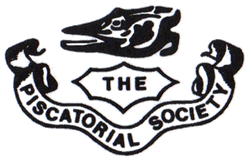The Wylye Grayling and Trout Survey (WGTS) has been monitoring grayling and brown trout populations since 1996 at multiple long-term sites on the River Wylye, Wiltshire. It is a collaborative project between Natural Resources Wales, the Piscatorial Society and the GWCT, and supported by the Grayling Research Trust, the Grayling Society and Wessex Water.
 Location of the six long-term sites on the River Wylye where the WGTS has been monitoring
Location of the six long-term sites on the River Wylye where the WGTS has been monitoring
grayling and brown trout populations since 1996. (Map taken from Bašić et al., 2018)
Annual surveys take place in autumn each year. Quantitative electro-fishing is used to estimate the abundances of all grayling and trout age classes, and data is collected on each captured individual’s condition, including a scale sample that is used to verify their age.
 Annual autumn electrofishing surveys on the River Wylye. (Photograph supplied by Dick Hawkes)
Annual autumn electrofishing surveys on the River Wylye. (Photograph supplied by Dick Hawkes)
Captured grayling are tagged to identify individuals that are recaptured in a subsequent survey year. This is done with a combination of visual implant (VI) and passive integrated transponder (PIT) tags.
 Processing the captured grayling and trout includes recording fish length (measured from tip of
Processing the captured grayling and trout includes recording fish length (measured from tip of
the snout to the fork of the tail in mm) and weight (g), which can be used to determine individual
fish condition. (Photograph supplied by Dick Hawkes)
The WGTS is thought to be the most comprehensive and consistent grayling population survey in Europe, and crucial to better understand drivers of their population change. Long-term patterns suggest a recent decline in the Wylye grayling population, but an increase in the Wylye brown trout population. Completed and current research projects, such as a study exploring the environmental drivers of European grayling recruitment, aim to understand what could be causing the changes in these populations, and how we might manage river habitats to conserve both fish species.

